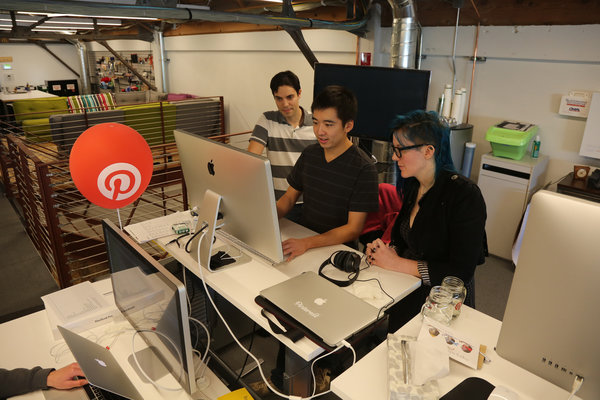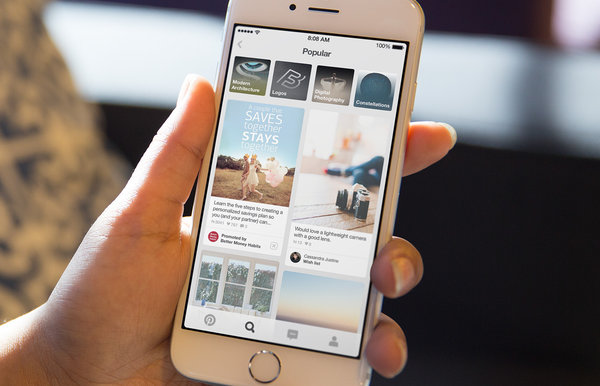A quick glance at the digital scrapbook Pinterest makes it seem like the anti-Facebook. It has no stream filled with friends’ faces and baby pictures, but rather a sprawling, colorful grid of recipes, photographs of clothes and a shopping list of presents to buy for loved ones.
Yet Pinterest wants to be like Facebook in one notable way: Soon some of the slick-looking photos on its site may be advertisements from the world’s biggest consumer brands — ads, Pinterest hopes, users actually want to see.
On New Year’s Day, the company plans to start selling ads on the site to marketers, sounding the call that Pinterest is open for business and that it wants to compete for ad dollars with the likes of Google, Twitter and Facebook.
It is the first major step for Pinterest toward building a scalable business. And though its major competitors have been pursuing advertising for years, Pinterest says its strength stems from the very nature of its service, in which users create collections of items they want or gather information about places they want to go — so-called aspirational content.

Pinterest’s offices. Advertisers tell the company it is the only place their brands feel welcome. Credit: Jim Wilson/The New York Times
“On Facebook, you think about friends, and on Twitter you think about news,” said Joanne Bradford, Pinterest’s head of partnerships, who is responsible for building the company’s business. “On Pinterest, you think about what you want to do, where you want to go, what you want to buy.”
Think of Pinterest as a kind of digital corkboard for things you want to collect. A newly engaged couple, for instance, might type “wedding gifts” into the site’s search function, and Pinterest will serve up photos of items like matching bath towels, flatware or baking pans. From there, the couple can “pin,” or save for later, any items they are interested in or want others to buy for them.
Begun in Palo Alto, Calif., in 2010, the Pinterest site has grown to about 70 million users globally, according to estimates from comScore, the research company. Pinterest, which employs more than 450 people and is now based in San Francisco, has raised more than $760 million in venture capital. Despite having little to no revenue to speak of, the company is valued by investors at $5 billion, a striking amount even by Silicon Valley standards.
Ultimately, Pinterest aims to do for discovery what Google did for search. That is, instead of knowing what you want and letting Google tell you exactly where to find it, Pinterest wants to introduce people to new experiences and new things to buy.
That is where the advertising comes in. Introduced to a handful of advertising partners in a limited test in June, the new ads look much like the other content on Pinterest. Marketers pay to create a Promoted Pin ad, and target it to certain groups of people based on their location, sex and the type of topic they have shown interest in.
For example, a Promoted Pin from Kraft Foods, one of Pinterest’s early partners, could show up on a Pinterest board of chili recipes collected and browsed by someone who is on a mobile phone while grocery shopping.
Pinterest says early results are promising. Brand advertisers see Promoted Pins “re-pinned,” or shared by users, an average of 11 times per advertisement. That means that every ad will be seen, on average, by 30 percent more people than the brand paid to show it to because users have shared the ad with friends.
Creating ads that people not only enjoy but share with others is something marketers strive for but rarely accomplish.
“We’re aiming for the holy grail here: trying to provide the right content to the right people, at the right time,” said Dana Shank, an associate director at Kraft Foods. “To be on a platform where people are actively looking for that content? That’s invaluable to us.”
Many social networks, including Twitter, Facebook and Instagram, have similar so-called native advertising products, or ads that are made to look like the content on the service. But on Pinterest an advertisement for, say, Cinnamon Toast Crunch cereal, which is made by General Mills, another early Pinterest partner, may look a little more natural when mixed in with the wealth of recipes on the site.
“Advertisers tell us Pinterest is the only place where their brand feels truly welcome,” Ms. Bradford said.
Still, Pinterest has a lot of catching up to do. Facebook, which has more than 1.3 billion users, generated $3.2 billion in revenue last quarter. Google, the world’s pre-eminent search engine, had $16.5 billion in revenue for that period.
“Pinterest definitely has a lot of potential, because the nature of the activity is totally commercial,” said Debra Aho Williamson, principal analyst at eMarketer. “But if you look at where its business is compared to Facebook or Twitter, it still has a lot of work to do.”
It may also be a challenge for Pinterest to persuade advertisers to create custom content for yet another social media platform, a process that can be labor intensive and, if done poorly, costly and ineffective. Facebook hosts sessions called publishing garages, which help teach ad agencies and brands how to make the best type of ads for Facebook. Twitter, too, has a list of best practices and its own services for big-spending marketers.
Pinterest wants to try something similar. It will soon start the Pinstitute, its way of teaching marketers how to create the best ads for the site. All businesses will be invited to attend one of the quarterly sessions, which will begin in March.
Eventually Pinterest wants to offer online courses and tools tailored to small and midsize businesses.
But for now, Pinterest is focused on big brands with deep pockets — especially those that offer products that may not seem to be as natural a fit for Facebook or Twitter.
“On a lot of other social platforms, if people don’t see your information in their main stream, it’s not necessarily going to be seen at all,” said Jason Merideth, a brand manager for Dreyer’s Grand Ice Cream, another early Pinterest partner. “Pinterest is great because our ads are passed around for a long time like any other content.”
by Mike Isaac, December 28, 2014
A version of this article appears in print on December 29, 2014, on page B1 of the New York edition with the headline: Pinterest Pushing Deeper Into Ads.
Images courtesy of The New York Times and Jim Wilson of the New York Times.

